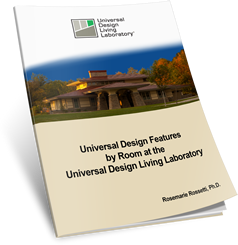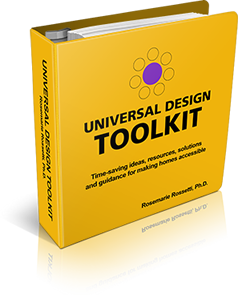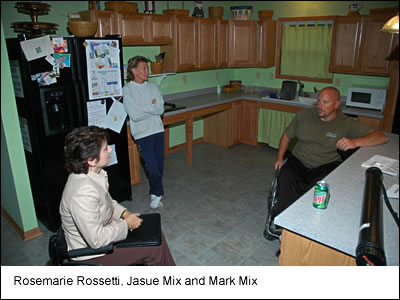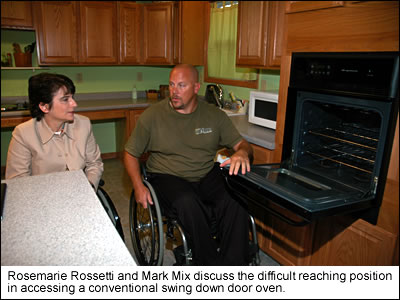
Discover how to live at home more affordably -- with independence, safety and dignity.
Get a sneak-peek at the "Universal Design Toolkit" with this free chapter filled with advice, tips and money-saving resources!

Build your awareness of what universal design features should be incorporated into homes.
Get the newly released "Universal Design Tookit", based on this real life demonstration home.

|
|
Article:
Making A Kitchen Work for YouAction Magazine
February 2007
By Rosemarie Rossetti
Copyright © 2007 Rosemarie Rossetti
Publication copyright © 2007 United Spinal Association
|
Last fall, my husband and I met Mark and Jasue Mix of Warsaw, Ohio, who had recently built a home along universal design principles. An Iraq war veteran who was injured in the war, Mark now uses a wheelchair. We were curious about the universal design features used in the Mix home that we could incorporate in our own new home (and future Universal Design Living Laboratory www.udll.com).

As we entered the kitchen and stopped to chat at the center island, Mark handed me a list of things that he and his wife wished they had done differently. If they could have done it over, they would have made the kitchen bigger, installed a shallower sink to give Mark knee space to roll under it, and lowered the wall cabinets. Mark could only reach the first and second shelves from his wheelchair.
Many short people who don’t use wheelchairs also complain that they can’t reach items on their top shelves. One solution is to lower the wall cabinets. Unfortunately, some of the items typically stored on the countertop like the blender, bread maker, and mixer, need vertical space. Traditionally, to accommodate this needed height, the bottom of the wall cabinet is installed 18 inches above the countertop. Alternatively, upper shelves can be made reachable by installing hardware that allows the contents of the shelves to come down to you. For example, in my wall cabinets, I am planning to install a pull-down shelf mechanism made by Häfele America Co., Archdale, NC.
It’s unfortunate that the Mix kitchen is missing a dishwasher—a convenience that most of us find invaluable. Mark’s builder told him that since the countertops had been lowered to 33 inches above the floor, a dishwasher would not fit under the counter. It is obvious that the builder had never built a universal design house before. A simple solution would have been just to raise the dishwasher.
I noticed the lack of height of the “toe kick,” the space at the base of the cabinets. A person in a wheelchair needs space––generally 9 to 10 inches––for the footrest and feet to clear the cabinet base. Oddly enough, the builder had actually cut off the base on some of the cabinets in order to install them lower! This was not a good solution, because now Mark has no space for his feet and must position his wheelchair sideways to have access to the countertop.
For my new home, I have selected KraftMaid Cabinetry, Middlefield, OH. The universal design Passport Series of cabinets has toe kicks that are 9 inches high by 6 inches deep. This series also has a raised dishwasher cabinet and a lowered wall oven cabinet.
The center island in the Mix’s kitchen can be used as a place to eat meals if you can sit on bar stools. Of course, this means Mark or anyone else who uses a wheelchair can’t eat there. A better solution would have been to design the island with two countertop heights, or to lower the island to 30 inches so Mark could join his family for informal dining in the kitchen.

Mark had the oven installed at the right height for accessibility. I would have preferred, however, a side-hinged oven rather than one hinged at the bottom. This allows safer access to hot items that need to be taken out. I am planning to install a Gaggenau side-hinged oven in my new home.
Other things that work in the Mix kitchen: It was easy to maneuver on the Mix’s vinyl floors. I have found that tile floors are not very easy to roll on in a wheelchair due to the slight bumps over the grout. Hardwood floors offer another great flooring surface for kitchens.
A roll-in pantry closet was adjacent to the kitchen. Shelves were mostly accessible for Mark, except the top one, where he needs to use a reacher. To enable Mark to have good turning space, he needs to keep items off the floor.
The cooktop had a clear area underneath so Mark can comfortably position himself at the burners. The control knobs were on the side of the unit and also in reach. The 24-inch countertop depth was perfect for Mark, allowing him room to work and the ability to reach the light switches on the wall.
A microwave was positioned on the counter, also at a great height for Mark to access.
The kitchen is one of the most lived in areas of the home and oftentimes the hardest room to make accessible for people who use wheelchairs. Special attention needs to be taken in the design phase. Take into consideration how many people will need to work together in preparing meals, setting the table and doing the dishes. Utilize the services of a universal design expert and review your special needs with that professional. Spend the time in planning rather than wasting money and regretting your decisions after the kitchen is constructed.
Rosemarie Rossetti, Ph.D. is building a national model universal design home in metropolitan Columbus, Ohio. She is an internationally known speaker, trainer, consultant, and writer. To contact Rosemarie go to: www.RosemarieSpeaks.com. To learn more about the Universal Design Living Laboratory go to: www.UDLL.com.